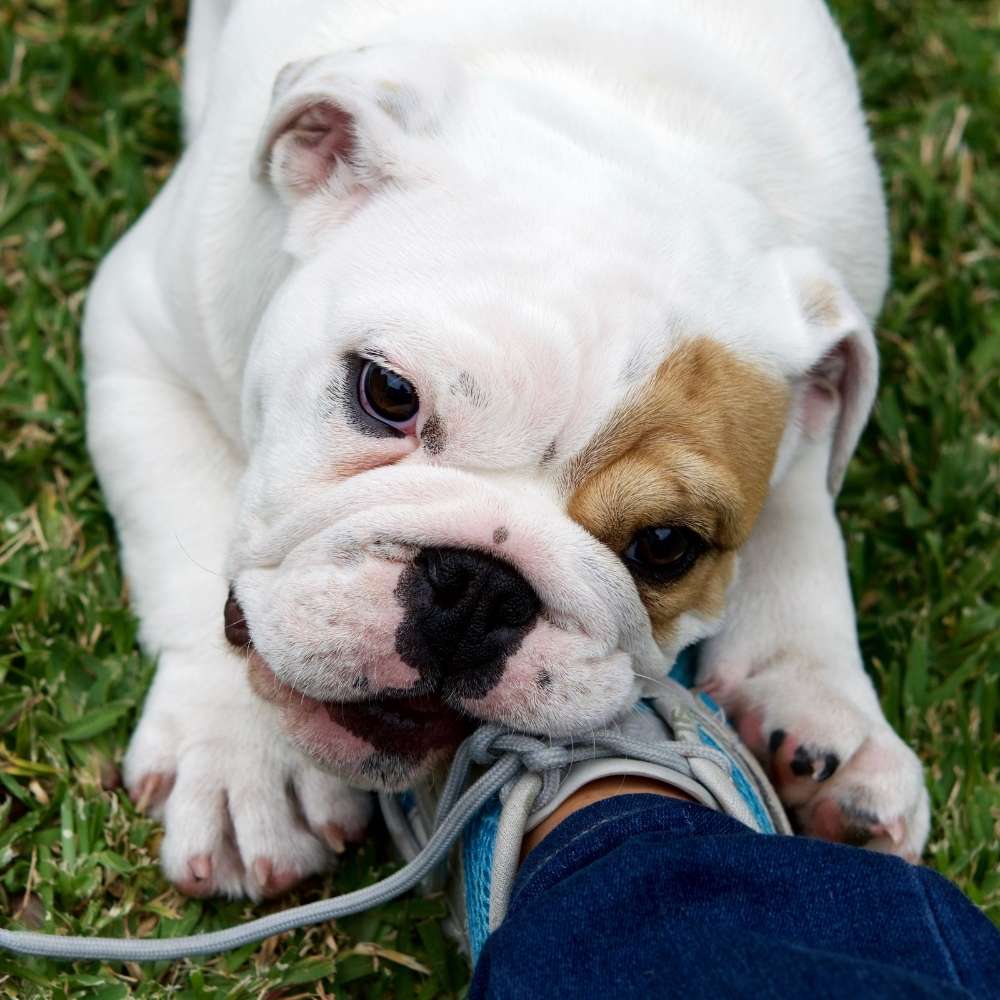Physical Address
304 North Cardinal St.
Dorchester Center, MA 02124

Table of Contents
Dog Teething Symptoms: Puppy Teething Tips 2021

Have you ever wondered why your puppy loves to chew on your shoe or the side of your furniture? Are they just too hungry? Is it something more serious?
Puppies are exploring the world with their mouths since they are born with closed eyes and ears. Puppy biting and nipping is normal dog behavior.
But it can get a little excessive once they reach their teething stage. Your little fur-ball is a developing baby.
Its teeth, like humans’ teeth, are changing. Teething is a painful process to them as well.
At age 2 to 4 weeks, the dog’s baby or milk teeth start to come out. They will still be taken care of by their mom and be normally trained with other littermates.
At 5 to 6 weeks old, all 28 milk teeth will be present. They can start to eat moist/soft puppy food aside from taking milk from their mom.
If you are going to rehome the pups, this is the perfect stage to start feeding them little by little.
At age 12-16 weeks, their primary teeth will start to fall off, and secondary or adult teeth will begin to push out. This stage is the most challenging for fur-parents.

This teething period can be so stressful both for the pup and the fur-parent. So, here are some survival tips that we can give you.

Chewing helps them ease the pain that they feel because of their sore gums. It is the main reason why they keep on putting their mouth on everything they can reach.
Luckily, we have lots of toys to give them as an alternative to biting our wallet, cabinet, and a lot of other important stuff.
Most of these are chew toys. So, first things first, know your puppy’s chew style – is it a gentle nibbler or an aggressive chomper?
A gentle nibbler won’t finish its treat in one sitting. They take their time to chew on toys or treats slowly and nicely.
While aggressive chompers are the ones who can destroy or feast on whatever you give them in a short period.


It is a rubber toy that is fun to chew, chase, and fetch. It stands in several ways, so it will definitely challenge your pup’s instinct and stimulate its mental capacity.
Kong is gentle on your puppy’s gums, too. You can also make it more rewarding by stuffing it with some delectable treats, like frozen peanut butter, homemade yogurt or veggie paste, or kibbles.
It is highly recommended that you put it in the freezer for several hours or overnight before giving them to your pup. The cold Kong will soothe the gum pain.
![]() A bully stick is an all-natural, protein-rich, and easily digestible treat that you can also let your pup gnaw. Choose bully sticks that are odor-free.
A bully stick is an all-natural, protein-rich, and easily digestible treat that you can also let your pup gnaw. Choose bully sticks that are odor-free.
Bully sticks filled with the saliva of your puppy can make your home a little stinky. This one is perfect for aggressive pups.
A teething ring is another toy that you can put in a freezer. ![]() You may also insert some treats on its holes or spread some peanut butter to make it more appealing.
You may also insert some treats on its holes or spread some peanut butter to make it more appealing.
The nubs of the teething ring massage your pup’s gums and clean their teeth as they chew. It also helps release your dog’s anxiety and stress.
Nylabone is another edible chewing alternative for puppies. ![]()
It encourages rewarding and non-destructive chewing for them.
Due to its texture, it can also help clean their teeth and prevent tartar buildup.
So much for edible treats! ![]() Dog rope toys are safe as long as there are no loose strands or threads. You may want to trim it first before giving it to them.
Dog rope toys are safe as long as there are no loose strands or threads. You may want to trim it first before giving it to them.
You can dampen the rope, put it in the freezer, and let your puppy enjoy another cold treat. Not all dogs are the same, whether in size or breed.

Too small toys can pose harm, like choking or swallowing. If the toy is too big for your puppy, there is a big chance that he will not put great interest in it because it will be tiring for his mouth.
Broken pieces of toys can also be swallowed by your dog, which sometimes can be indigestible too. If this incident happens, it may lead to vomiting.
You may want to check in with your vet right away before severe damage is done.
Boredom is so typical to them. They will look for things to play with and let you know that they are bored by continuously interrupting or nipping on you.
Dogs enjoy novelty. To satisfy their need to chew and play, give their toys in rotation, not all at once. You can also try giving them chew toys in different shapes and textures.
Though it may look appealing to your dog, do not put this on your list. Rawhides contain some harsh chemicals, can make your pup super thirsty (which is not good if you are potty training them), and can cause throat and digestive tract blockage.

Dogs are fond of running. If they are grinding on one of your stuff, do not run after them, or they will think that it is a game. Simply ignore them. Dogs are social animals.
They hate being snubbed. Moreover, offer them an alternative chew toy or treat. And next time, make sure that your things are out of their reach.

Chewing is totally good for their developing gums and teeth. If they learn what and what not to chew on, praise them, pet them or reward them. A short walk outside is absolutely perfect.
On the last note, puppies should not be left alone even when they are so busy with their chew toys. Your supervision as a fur-parent is a must.
And never hit a dog! They didn’t choose this stage of their life, just like we don’t when our wisdom tooth attacks. So be patient and act like a real puppy lover.
Read: Basic Dog Training: 7 Basic Dog Commands
 MC Romesaint
MC RomesaintMC Romesaint is a Biological Science major and is currently teaching. She is an avid reader, aspiring writer, and book author. Reaching each vision, one step at a time. To God be all the glory!